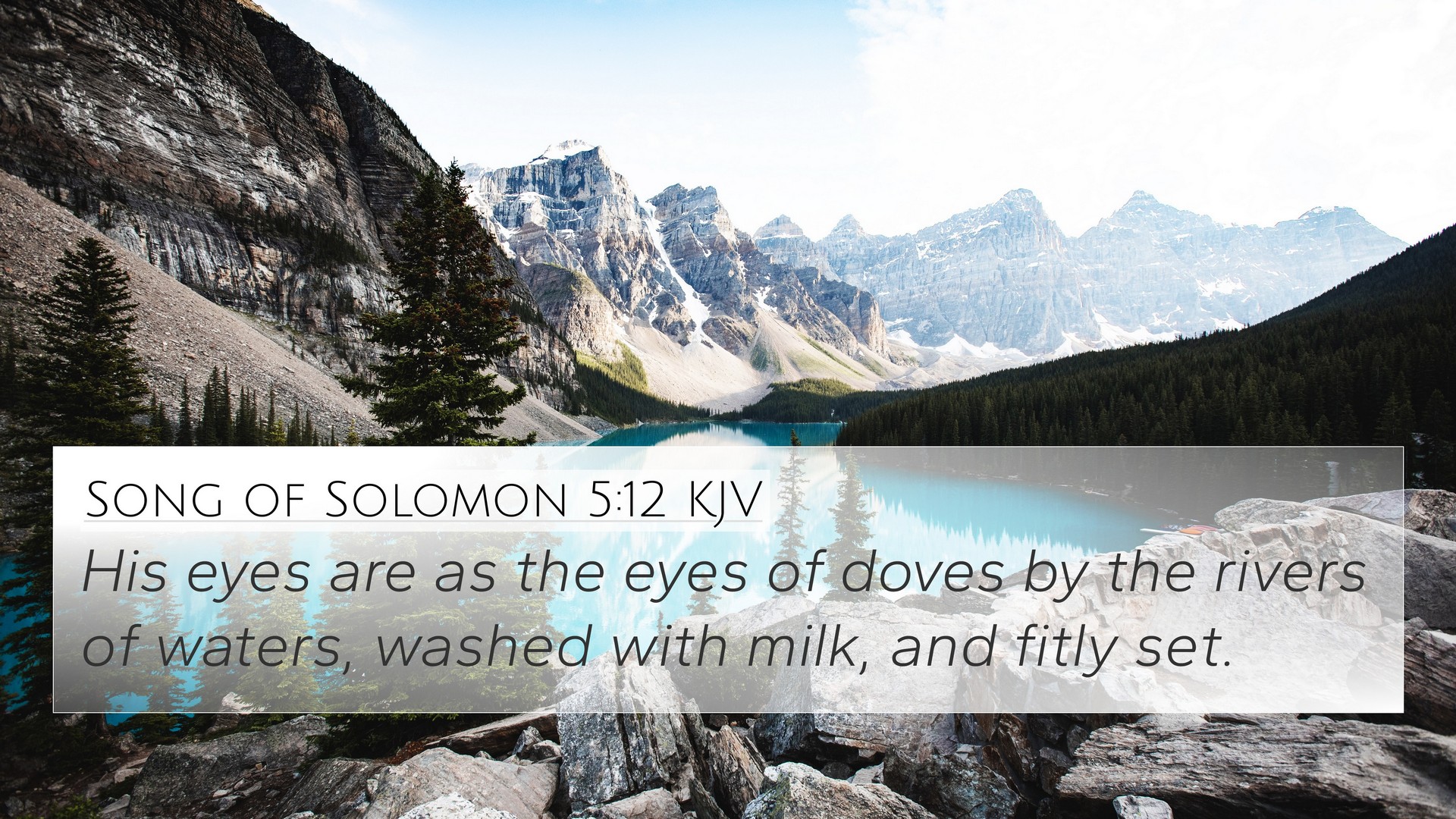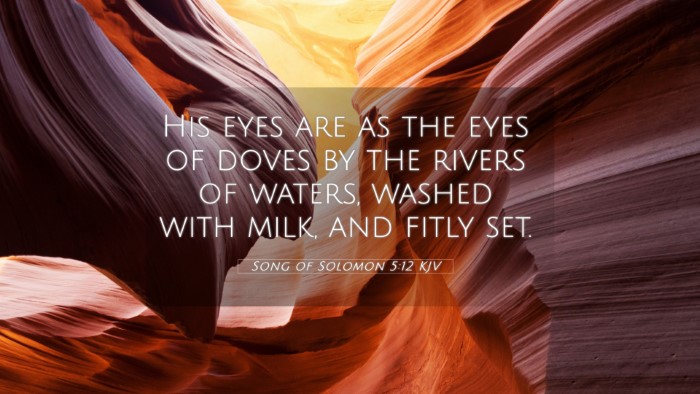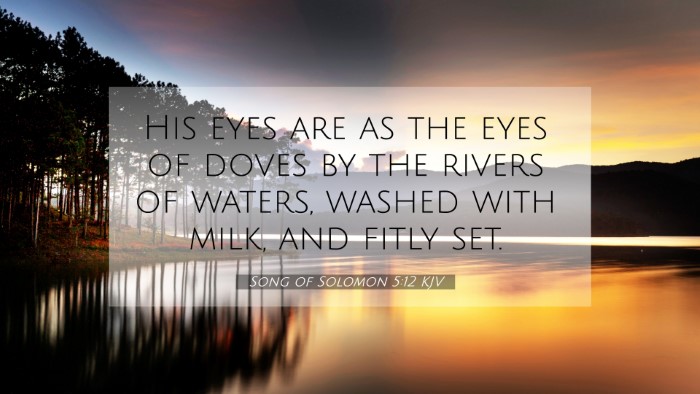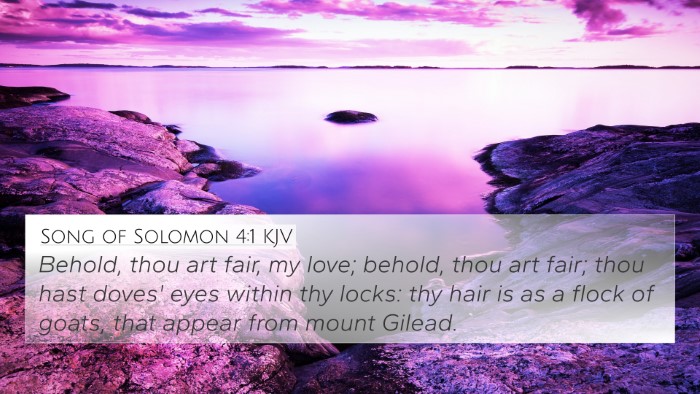Understanding Song of Solomon 5:12
The verse Song of Solomon 5:12 states, "His eyes are like doves by the water brooks, washed with milk, and fitly set."
This metaphorical passage, nestled in the poetic context of this book, presents a vivid image that conveys deep emotional and spiritual meanings.
Interpretation and Meaning
The eyes of the beloved are likened to doves, which symbolize innocence and tranquility. The water brooks suggest a refreshing, life-giving abundance, while "washed with milk" implies purity and richness.
The phrase "fitly set" suggests that the eyes are pleasing and well-placed, indicating the beloved's attractiveness and the joy the speaker finds in them.
Insights from Public Domain Commentaries
Matthew Henry's Commentary
Matthew Henry emphasizes the beauty of the beloved in this poetic section, highlighting that doves represent peace and gentleness.
The comparison of the eyes to doves by the water symbolizes the heart's affection and the emotional depth found in love.
Henry points out that the purity of the eyes reflects the purity and affection of the beloved's character.
Albert Barnes' Notes
Albert Barnes provides a detailed analysis of the imagery used in this verse. He notes that the doves' eyes suggest a certain softness and grace,
and the mention of flowing water connotes vitality and freshness in relation to the beloved’s spirit. Barnes also reflects on how the references to milk evoke nourishment,
reinforcing the idea that love is both sustaining and nurturing.
Adam Clarke's Commentary
Adam Clarke further expounds on the significance of doves in ancient texts, interpreting them as a symbol of affection and fidelity.
He points out that the washing of the doves' eyes with milk indicates a glamorous and pristine beauty, a hallmark of the beloved's attractiveness,
rendered by their purity and gentleness. Clarke's perspective blends well with the metaphor of the flowing water, tying together themes of love, purity, and devotion.
Cross-References to Song of Solomon 5:12
Understanding Song of Solomon 5:12 is enhanced when we look at related Bible verses that echo similar themes and imagery.
Here are several cross-referenced verses:
- Genesis 49:12 - "His eyes shall be red with wine, and his teeth white with milk." (The use of color as a symbol of richness)
- Matthew 6:22 - "The eye is the lamp of the body; if your eyes are healthy, your whole body will be full of light." (Signifying the importance of the eyes in conveying inner beauty)
- Psalm 45:10-11 - "Listen, daughter, and pay careful attention... the king is enthralled by your beauty." (The theme of beauty in a beloved)
- Proverbs 15:30 - "Light in a messenger's eyes brings joy to the heart, and good news gives health to the bones." (The connection between appearance, joy, and affection)
- Song of Solomon 4:1 - "How delightful is your gaze, your eyes like doves!" (Directly connects to the theme of beauty and love in the beloved)
- Isaiah 54:11 - "Afflicted city, lashed by storms and not comforted... your stones will be laid in their proper place." (The idea of beauty restored)
- 1 Samuel 16:7 - "The Lord looks at the heart." (Emphasizing the importance of inner beauty versus physical appearance)
Thematic Connections
The themes present in Song of Solomon 5:12 resonate throughout the scriptures in various forms. The connection of
love, beauty, and clarity in sight can be found across multiple Biblical contexts.
Exploring Inter-Biblical Dialogue
There exists a rich intertextual dialogue when we consider the links between the emotional expressions found in the Song of Solomon and
wisdom literature such as Proverbs, as well as prophetic literature from Isaiah and the Psalms.
Each of these scriptures enhances our understanding of the emotional landscape within Biblical love poetry and the
divine reflections of love portrayed across the texts.
Conclusion
In essence, Song of Solomon 5:12 serves as a vivid representation of love, beauty, and purity, which can be explored deeply through the lens
of various public domain commentaries and inter-Biblical connections.
Utilizing tools for Bible cross-referencing—such as a Bible concordance or a Bible cross-reference guide—can help to unveil further connections and
thematic elements entrenched within the scripture.





